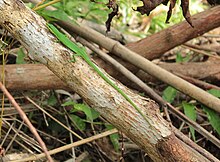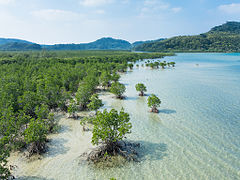Iriomote Ishigaki National Park
|
Iriomote Ishigaki National Park
|
||
|
Mangrove forest on the island of Iriomote-jima |
||
| location | Yaeyama Islands , Okinawa Prefecture , Japan | |
| surface | 1,221.5 km² | |
| WDPA ID | 747 | |
| Geographical location | 24 ° 19 ' N , 123 ° 53' E | |
|
|
||
| Setup date | May 15, 1972 | |
| administration | Japanese Ministry of Environment | |
| particularities | southernmost national park in Japan | |
The Iriomote-Ishigaki National Park ( Japanese 西 表 石 垣 国立 公園 , Iriomote-Ishigaki Kokuritsu Kōen ) is the southernmost national park in Japan . The park's land and water areas are in the Yaeyama Islands area in the East China Sea , within Okinawa Prefecture . It is named after the two main islands Iriomote and Ishigaki . The national park was founded in 1972 and expanded several times.
history
The national park was established on May 15, 1972 as Iriomote National Park. On August 1, 2007, the park was expanded to include the Ishigaki-jima island region and therefore renamed the Iriomote-Ishigaki National Park. The expanded area was 20,569 ha on land and 52,097 ha at sea. On March 27, 2012, the land area was expanded again to 21,958 ha and the sea area to 69,718 ha. Almost the entire area of Iriomote Island was declared a designated area on April 15, 2016, and the area was also expanded through the expansion of marine park areas and the designation of the Sagaribana community on the Hirakubo Peninsula in the northern part of Ishigaki Island. The land area of the national park was then 40,653 ha and the sea area 81,497 ha and thus the total area 122,150 ha. The Japanese Ministry of the Environment is responsible for the management of the park .
The island of Iriomote-jima was last together with the further northeast islands Amami-Oshima , Tokunoshima and the northern part of Okinawa as a candidate for the status of World Heritage by the Japanese Ministry of the Environment to the World Heritage Committee of UNESCO proposed. If the nomination is successful, this would be the fifth area within Japan to be designated as World Heritage (as of July 2017)
Park area

The majority of the land area lies on the two main islands of the name, Iriomote-jima in the west and Ishigaki-jima in the east, which belong to the Yaeyama Islands . The park also includes the smaller islands of Kuroshima , Kamiji-jima , Shimoji-jima , Kohama-jima , Kayama-jima and Taketomi-jima , which are located in the Sekiseishoko lagoon between the two main islands, as well as the Hatoma islands . jima in the north and Hateruma-jima and Nakanougan-jima in the south.
-
Iriomote-jima
- Mariyudu Waterfall : 20m drop height, part of the list of top 100 waterfalls in Japan
- Pinaisāra waterfall : 55 m drop
- Yonehara: Yaeyama palms , awarded as a National natural monument
-
Ishigaki-jima
- Nagura Amparu : Mudflat with 160 hectares of mangrove forest, which is a habitat for numerous bird species
- Kapp Hirakubo-zaki
- Mount Omoto : Highest mountain in Okinawa Prefecture
- Kabira Bay
-
Taketomi-jima
- Traditional townscape
- Hateruma-jima : Japan's southernmost inhabited island
Flora and fauna
As the southernmost of the Japanese national parks, the Iriomote Ishigaki National Park is already in the subtropical climatic zone and about 80% is covered with dense sub-tropical forest. The ecosystems in the park include evergreen mountain forests, forested wetlands on the coasts, as well as the largest mangrove forest and the largest coral reef in Japan. The diverse nature offers a habitat for a wide variety of animal and plant species. In the forests there are tree species such as oaks ( Quercus miyagii ) and pseudo- chestnuts ( Castanopsis Sieboldii ), while tree species such as Rhizophora mucronata and Heritiera littoralis grow in the mangrove forests and screw palms ( Pandanus odorifer ) and hibiscus grow in the coastal areas .
The island of Iriomote is the smallest island in the world where wild cats live. The Iriomote cat , a subspecies of the Bengal cat found only on this island , is classified as critically endangered on the IUCN Red List with probably fewer than 100 adults . Other endemic animal species are the also endangered lizard species Takydromus dorsalis and the endangered skink species Plestiodon kishinouyei . The southern Ryūkyū Islands are also the habitat for the rare bird of prey Spilornis cheela perplexus ( snake harrier ).
On the water surface of the national park, the coral reefs of the Sekiseishoko lagoon offer a biodiversity which, with over 360 verified coral species, is even comparable with the Great Barrier Reef (approx. 360 hard and 80 soft coral species). But as there, this diversity is now also declining, as both reefs are severely affected by coral bleaching due to rising water temperatures . According to a study by the Japanese Ministry of the Environment from 2017, around 70 percent of the corals in the Sekiseishoku lagoon are affected by bleaching.
natural reserve
The national park is classified with the IUCN protection category II. To protect the endangered Iriomote cats in particular, there are strict speed limits on the islands' roads. There are also ditches at the roadsides and numerous warning notices. Wounded and sick animals are treated and, if possible, released back into the wild. Introduced invasive animal species such as the cane toad and the green iguana pose a threat to many animals as well as to the entire ecosystem . Therefore, countermeasures are taken to prevent them from spreading and ongoing ecological studies are carried out.
activities

The park area offers a variety of leisure activities. The many beaches and the coral reef of the Sekiseishoku Lagoon are ideal for swimming, snorkeling and scuba diving . River trips to the mangrove forests are offered. Hiking and canoeing are also popular.
Most recently (2013) 1,990,000 people visited the national park each year.

gallery
Jungle along the Urauchi River ( Iriomote-jima )
Reef Manta Ray ( manta alfredi )
Individual evidence
- ↑ 西 表 石 垣 国立 公園 の 公園 区域 及 び 公園 計画 の 変 更. Japanese Ministry of the Environment, accessed December 27, 2019 (Japanese).
- ↑ 西 表 石 垣 国立 公園 の 大規模 拡 張 に つ い て. Japan Ministry of the Environment, April 14, 2016, accessed September 3, 2017 (Japanese).
- ↑ Application for UNESCO World Heritage Status. Japan Environment Quaterly (JEQ), accessed July 25, 2017 .
- ↑ a b c Guide of Highlights at www.env.go.jp. Japanese Ministry of the Environment, accessed October 17, 2017 .
- ^ Iriomote cat on the IUCN Red List. Retrieved December 27, 2019 .
- ↑ Takydromus dorsalis on the IUCN Red List. Retrieved December 26, 2019 .
- ↑ Plestiodon kishinouyei on the IUCN Red List. Retrieved December 26, 2019 .
- ↑ Distribution area and individual sightings of the Spilornis cheela ssp. perplexed . Retrieved October 14, 2017 .
- ↑ Japan's largest coral reef is dying. In: Spiegel Online. Retrieved October 10, 2017 (German).
- ^ Statistics from the Japanese Ministry of the Environment . Japan Ministry of the Environment, 2016, accessed December 25, 2019 .
Web links
- Iiriomote Ishigaki National Park on env.go.jp (English)
- Map of the Iriomote Ishigaki National Park on env.go.jp (PDF 1,252 KB, scale 1: 191,000, English)
- Iriomote-Ishigaki National Park on the Japanese National Park Foundation website (English)
- World Database on Protected Areas - Iriomote-Ishigaki National Park (English)









